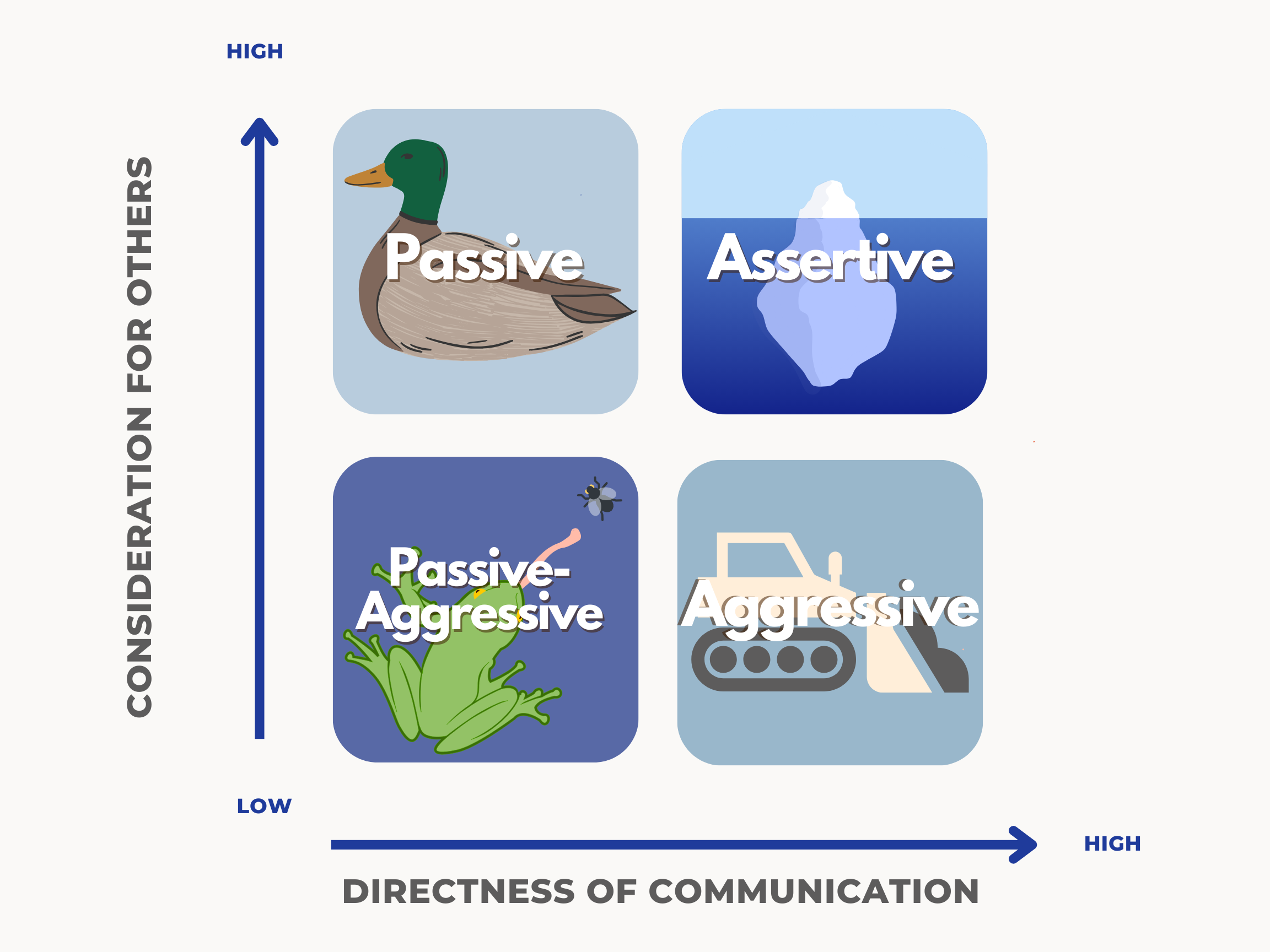Part 1: Communication Styles
In previous posts we’ve talked about the importance of learning the language of emotion and deciphering the corresponding unmet need. One perk of being better acquainted with your needs and emotions is that you can communicate your needs more intentionally and effectively. We are all capable of using different communication strategies depending on what the situation calls for. However, we tend to rely on one strategy more heavily than the others. Today I’m going to walk you through 3 common strategies that seem effective in the short-term but are ultimately not effective long-term in balancing the need for connection with the need for autonomy. See which style sounds most familiar to you.

Passive
“Can’t we all just get along?”
Aim: Peace, Harmony, Self-Preservation
A passive communicator prioritizes an end to the conflict at the expense of his/her own needs. Think of your submissive, people pleasers. They swallow their anger, their hurt, their disappointment, and other people’s aggression. They often give the impression from the outside that they are completely calm and unaffected. Or they may minimize the inconvenience to themselves when someone hurts them. But much like a dormant volcano that is calm at the surface, the passive communicator has all of that unexpressed emotion roiling on the inside, building pressure. Resentment can build until passive communicators suddenly erupt out of the blue, before returning to their calm, dormant appearance. Eruptions can be outbursts aimed at others or aggression aimed inward in the form of habits like binge eating, restrictive eating, excessive exercise, substance use, risky sexual behaviors, etc.
This style can also be likened to a floating duck. On the surface, all you see is a duck gracefully and effortlessly gliding across the water. What you can’t see from the shore is the duck’s feet paddling furiously below the surface. Passive communicators may seem unperturbed by the conflict, but under the surface, they are working furiously to appease the situation and restore calm.
What Passive style sounds like:
- “That’s ok. It’s no big deal.” (When it really is.)
- “I don’t want to be a bother.”
- “Whatever you want to do.”
- Avoiding eye contact
Pros of a Passive style:
- Minimizes damage in the face of a threat you can’t fight off. For example, they say when faced with a grizzly bear to play dead. Without a weapon, a human is no match for a hungry grizzly. The best chance of survival is to play dead to minimize the damage.
- Creates few enemies. Passive communicators can be well-liked because of their aim to be pleasing to those around them.
Cons of a Passive style:
- Easy target for taking advantage. Because passive communicators won’t speak up when something isn’t fair, aggressive and passive-aggressive communicators can easily impose on their needs.
- Hard to get needs met. It’s hard for your emotional and physical needs to be met when no one knows what they are.
- Denial
- Avoidance of a problem that only makes it bigger.
- Hard to build intimacy with others. Intimacy requires vulnerability. It’s hard to be vulnerable when you’re minimizing your own needs.
TV/Movie Characters with a Passive Communication Style:
- Garry Gergich, Parks and Recreation, “Garry is my real name. Yes, after 30 years my coworkers are finally going to call me by my real name. Oh boy I am blessed.”
- Toby Flenderson, The Office
- Ted Lasso
- Chidi Anagonye, The Good Place
- Janine Teagues, Abbott Elementary, “Look at that: Crocodiles and parakeets can be friends.”
- Sharon Streslecki, Kath & Kim
- George-Michael Bluth, Arrested Development
- Pete, Ghosts
- Olaf, Frozen
Passive -Aggressive
“Guess what I’m mad about.”
Aim: To fight back while maintaining the façade that you’re not a fighter
Like its name suggests, this communication style straddles both passive and aggressive strategies. Like passive communication, it has little regard for self-need by using an indirect method of communication. On the surface passive-aggressive communicators can seem pleasant and unaffected. However, under the surface, their anger and resentment roils. Unlike the passive communicator, though, the passive-aggressive type takes indirect jabs at others instead of swallowing everything till they explode. This can come out in sarcasm, contempt, projection, minimization, and mockery. They may say one thing with their words but mean something else with their tone and body language. They will make those around them feel their displeasure. Like aggressive communicators, passive-aggressive types will also be defensive, though they will make you guess what they’re actually angry about. It’s like sending mixed signals. If I nodded yes but said no at the same time, you’d be confused about whether I meant yes or no. Passive-aggression is similar. For the person on the receiving end, it can feel confusing and dangerous because the messaging isn’t clear and yet the stakes feel high. This communication style can be likened to an iceberg. The passive-aggression only gets at the surface, the tip of the iceberg. It’s misleading because it makes it seem like a tiny piece of floating ice when most of the mass is below the surface.
What Passive-Aggressive Style Sounds Like:
- “That would have been nice to know ahead of time.”
- “I love having to stay late to fix everyone else’s mistakes.”
- “I’m not the one with the ego problem.”
- “Don’t get upset.”
- Playing the victim/villainizing others
- Giving someone a dirty look when their back is turned
- Giving someone the silent treatment
Pros of a Passive-Aggressive Style:
- Allows for some push-back without directly challenging a bigger threat
- Better chance of needs being met than with passive style
Cons of a Passive-Aggressive Style:
- Hard for others to trust what you say
- Alienates others
- Personal needs are unlikely to get met through sarcasm and other aggressive strategies
- Defensiveness
- Projection
- Communicator feels shame
TV/Movie Characters with a Passive-Aggressive Style:
- Angela Martin, The Office, “I once reported Oscar to the INS. Turns out he’s clean, but I’m glad I did it.”
- April Ludgate, Parks and Recreation, “I very maturely and straightforwardly left anonymous comments about her online.”
- Barney, How I Met Your Mother
- Marlin, Finding Nemo
- Meredith Blake, The Parent Trap
- Haymitch, The Hunger Games
- Kreacher, Harry Potter
- Tahani, The Good Place
- Jacob Hill, Abbott Elementary
Aggressive
“Agree with me and do what I say.”
Aim: Control, Dominance
This communication strategy is outright and direct. Aggressive communicators don’t pull punches and tend to be forceful or threatening. They tend to be confident and skilled at exerting control over others. They can be hostile and intimidate others into meeting their needs, or they can be well-intentioned but end up steamrolling everybody in the process. Either way, aggressive communicators prioritize their own needs at the expense of others. These are dominant types who struggle to hear other voices or share control. They often become defensive when confronted and can be in denial about their own issues. Like a bulldozer flattening everything in its path, aggressive communicators don’t back down.
This strategy can be useful when you are faced with a threat that isn’t too powerful for you. For example, black bears are dangerous wild animals. However, they are easily frightened. Getting bigger and louder when faced with a black bear (a.k.a. being aggressive) is actually the best way to avoid getting attacked. Similarly, sometimes relational threats are best fought off with aggression. For example, if you get tough with a bully and dish it right back, they’ll know they can’t mess with you in the future. However, in the long-term, aggression, like passivity and passive-aggression are not sustainable strategies. They are useful in specific, isolated circumstances, but they will cause more damage in the long run.
What Aggressive Style Sounds Like:
- “You’re doing it wrong.”
- “Don’t be upset.”
- “Suck it up.”
- “We’re doing this. End of discussion.”
- Direct eye contact.
- Invades personal space.
Pros of Aggressive Style:
- Your needs get met quickly.
- Others know what to expect with you.
- Can effectively fight off a threat.
Cons of Aggressive Style:
- People can fear or resent you.
- Pushes people away.
- Miss out on other voices and ideas.
- Creates unnecessary conflict.
- Isolation
- Shame
TV/Movie Characters with an Aggressive Style:
- Leslie Knope, Parks and Recreation
- Eleanor, The Good Place
- Anger, Inside Out
- Crabbe and Goyle, Harry Potter
- Biff, Back to the Future
- Melissa Schemmenti, Abbott Elementary
- Severus Snape, Harry Potter
- Gimli, Lord of the Rings
Hopefully now, you have a better understanding of what strategy you fall into in moments of stress of conflict. The first step is recognizing it and understanding the benefits and drawbacks of that strategy. In a future post, we will continue this journey of self-knowledge and self-improvement by learning how to have a more effective communication strategy in the short-term and the long-term. Here’s a challenge for you this week: try to notice when you start to use your strategy of choice. Notice what is going on around you. Notice what you are feeling and thinking. Notice what you might be needing in that moment. Notice how the other person responds and see if you can identify their communication strategy as well.
Communication is essential to connection, intimacy, and even autonomy. Learning more about yourself and how to be a more effective communicator is an important step toward having the relationships and quality of life that you want. This post and the references used to research it are a great way to get started. But if you feel like you’d like more support in this area, consider going to therapy. At the Couch Method, we would love to help you with your communication goals. We are just a phone call away!
References
https://www.qualitygurus.com/4-communication-styles/
https://umatter.princeton.edu/respect/tools/communication-styles
https://blog.lucidmeetings.com/blog/succeeding-with-the-5-communication-styles-you-find-in-meetings/

